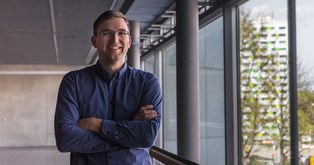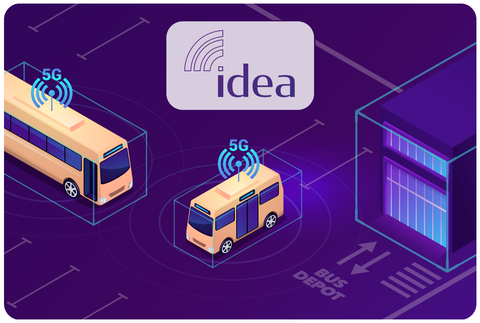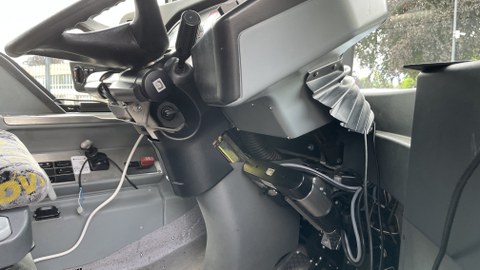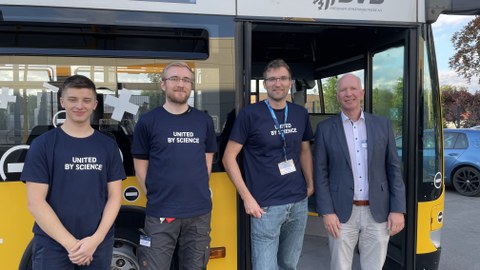IDEA - Innovative Depot-Automatisierung
Table of contents
Project details
Project duration: 01.04.2023 – 31.12.2024
Funded by: Federal Ministry for Digital and Transport (BMDV)
Budget: 3,5 Mio. €
Funding: 2,9 Mio. € (1,7 Mio. € TU-Dresden)
Motivation
The increase of automation in depots of transport companies allows in perspective the reduction of personnel deployment. Especially tasks like driving to the car wash, gas station/charging station or parking the buses at the end of the shift can be automated to reduce personnel costs and to relieve the driving personnel from tasks at the end of a shift.
Thanks to depot management systems and components already present in modern vehicles, the prerequisites for increasing automation of depot processes are in principle in place, but there is a lack of suitable infrastructure and standardized interfaces for linking the subsystems. This is where the IDEA project comes in.
Project goals
The IDEA project aims to explore the automation of depots of public transport companies using innovative radio-based communication between automated vehicles as well as a depot management system via a 5G campus network:
- Research appropriate architectures and interfaces to harness the communication and location functionalities of the 5G campus network for depot automation.
- Research the standardization requirements for depot automation to translate into appropriate standardization activities at the national and international levels
- Evaluate the location accuracy required for automated driving and docking of vehicles at the depot
- Upgrade of a conventional 18m articulated bus for real-world tests to validate the functions of depot automation
Main focus of the Chair of Vehicle Mechatronics
The main focus of the professorship for vehicle mechatronics in the IDEA project is the provision and conversion/upgrading of several automated vehicles as well as the testing of the effective chain of 5G communication - 5G localization - vehicle control and the investigation of interference effects and fault cases on the safety of the automation systems.
Our tasks include:
 © Ansgar Dietermann
© Ansgar Dietermann
Project Manager
NameDr.-Ing. Steffen Kutter
Send encrypted email via the SecureMail portal (for TUD external users only).
- Creation of a minimal or low-cost sensor concept for later retrofit solutions and evaluation in corresponding simulation environments.
- Prototypical integration of sensors in a conventional 18m articulated bus
- Development and design of vehicle controllers and automation functions for large commercial vehicles (e.g. articulated buses) as well as integration of a interface for the depot management into the vehicles
- Extensive investigation of the systems in real-life tests for evaluation and validation of the research projects
Project development
Das Gelände in Torgau soll im Projekt IDEA als Reallabor für die Versuchsdurchführung zur Validierung der zuvor in Simulationen entwickelten Fahrfunktionen dienen. Zudem soll hier ein 5G-Campusnetz zur unterbrechungsfreien Indoor- und Outdoor-Lokalisierung aufgebaut werden.
Bei der ersten Begehung durch die Professur für Fahrzeugmechatronik wurde das Gelände mit unserem eCrafter aus dem Projekt ABSOLUT mittels Lidar-Sensoren kartiert. Zudem wurden kritische Bereiche für den Aufbau der Simulationsumgebung vermessen und erste Untersuchungen zur Güte der Lokalisierung des Fahrzeug mittels GNSS durchgeführt.

3D Lidar-Karte des Geländes in Torgau
With the installation of a drive-by-wire system (DBW), the bus is enabled for computer-based control. The integration of mechanical actuators on the steering column and the brake pedal enables these to be controlled via a CAN signal, which is generated by the main control computer from the automated maneuver planning, for example. As an electronic accelerator pedal is already installed in the vehicle, only an electrical connection with a control unit of the DBW system is required for computer-based control. The CAN interface also enables remote control of the vehicle by means of external communication via 4G/5G, or other connections.
The DBW is designed with multiple redundancy in the number of control units, servomotors, potentiometers for determining the actuator positions, CAN lines and signals on the CAN bus. In addition, the system has its own batteries in the event of a power failure. The system can be overridden and the brake can be actuated by the safety driver at any time and in all driving situations.
A first public demonstration of the system took place at the Dresden Science Night at TU Dresden on 14.06.2024.
For the Dresden Science Night 2024, we demonstrated the function of the integrated drive-by-wire system in our 18m Citaro articulated bus on the premises of the Fahrzeugtechnisches Versuchszentrum (FVZ) near Wasaplatz for all interested visitors.
Guests of all ages were able to control the steering and brakes of the bus themselves using an XBox controller and observe the drive-by-wire system in action. There were many interesting discussions and questions about drive-by-wire, vehicle sensors and vehicle automation. We would like to thank everyone for their active participation and the many good and also critical questions.
Project partners
Hochpräzise Fahrzeugortung sowie hybride echtzeitfähige Fahrzeugvernetzung (5G-Kommunikation und 5G-Lokalisierung), Realisierung Multi-RAT Lokalisierung, Depotautomatisierung
Modellierung eines gemeinsamen digitalen Zwillings zur Verwendung in der 3D-Funknetzplanung und dem autonomen Rangieren; 3D-Funknetzplanung eines R16+ 5G Netzes unter Beachtung der Ortungsfunktionen
Systemintegration, Standardisierung und Definition der Schnittstellen zum Depot-Managementsystem





